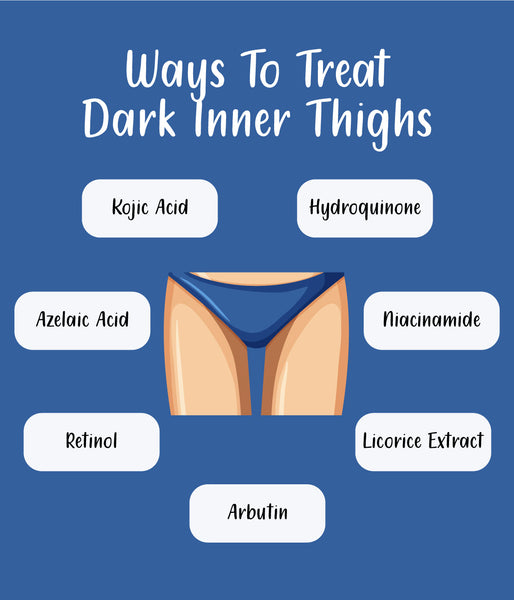Why Are My Inner Thighs Dark? A Dermatologist-Approved Guide

Key points
- Wearing tight clothing or non-breathable fabrics.
- Having a body shape where thighs naturally touch.
- Being overweight, which can increase the surface area of skin-on-skin contact.
Dark skin on the inner thighs is an incredibly common experience, yet it often becomes a source of self-consciousness and concern. If you've found yourself wondering why this area is a different shade, you're not alone. The discoloration is usually harmless, but understanding its root causes is the first step toward effective management and feeling confident in your skin.
This comprehensive guide, synthesized from dermatological advice, clinical studies, and real-user experiences, will explore the science behind dark inner thighs, differentiate between normal pigmentation and medical concerns, and outline the most effective strategies for treatment and prevention.
What Causes Dark Inner Thighs? Understanding Hyperpigmentation
The darker appearance of the skin on your inner thighs is a form of hyperpigmentation, which simply means the skin is producing an excess amount of melanin, the pigment that gives skin its color. This overproduction isn't random; it's a response to a trigger. Let's break down the most common culprits.
Friction and Chafing (The Most Common Culprit)
The primary cause for most people is chronic friction. When your thighs rub against each other while walking, running, or exercising, the skin becomes irritated and inflamed. To protect itself from this constant trauma, the skin thickens and produces more melanin, resulting in a darker appearance. This is known as post-inflammatory hyperpigmentation (PIH).
Factors that increase friction include:
- Wearing tight clothing or non-breathable fabrics.
- Having a body shape where thighs naturally touch.
- Being overweight, which can increase the surface area of skin-on-skin contact.
Hormonal Fluctuations
Hormones play a significant role in regulating melanin production. Imbalances or shifts can lead to darkened skin in various areas, including the inner thighs.
- Polycystic Ovary Syndrome (PCOS): This hormonal condition is often linked to insulin resistance, which can cause dark, velvety patches of skin known as acanthosis nigricans.
- Pregnancy and Menstruation: Fluctuations in estrogen and other hormones during these times can stimulate excess melanin production.
- Hormonal Contraceptives: Some people may experience hyperpigmentation as a side effect of birth control pills.
Underlying Medical Conditions
While usually benign, dark inner thighs can sometimes signal an underlying health issue that needs attention.
- Acanthosis Nigricans: This is a key condition to be aware of. It causes dark, thick, velvety skin in body folds like the groin, armpits, and neck. It's strongly associated with insulin resistance, pre-diabetes, and type 2 diabetes. Treating the underlying cause is crucial for improving the skin's appearance.
- Fungal Infections: Infections like Tinea cruris (jock itch) can cause inflammation and lead to post-inflammatory hyperpigmentation even after the infection has cleared.
- Genetic Disorders: In rare cases, conditions like Darier's disease can cause hyperpigmentation.
Other Contributing Factors
- Skin Irritation: Eczema, psoriasis, or irritation from hair removal methods like shaving or waxing can inflame the skin and lead to darkening.
- Dry Skin: A buildup of dead, dry skin cells can make the area appear darker.
- Medications: Certain drugs, including some chemotherapy agents and antibiotics, can cause hyperpigmentation as a side effect.
- Sun Exposure: UV radiation stimulates melanin production. If your inner thighs are exposed to the sun, they can become darker.
 Source: Isya Aesthetics
Source: Isya Aesthetics
When to See a Doctor
It's important to distinguish between common hyperpigmentation and something that requires medical attention. You should consult a doctor or board-certified dermatologist if:
- The darkening appears suddenly and without an obvious cause.
- The skin's texture changes, becoming thick, velvety, or leathery.
- The area is painful, itchy, or has an odor.
- The discoloration is spreading rapidly.
- You have other symptoms that could indicate a condition like diabetes or PCOS.
How to Lighten Dark Inner Thighs: A Comprehensive Treatment Guide
Managing dark inner thighs requires a two-pronged approach: treating the existing discoloration and preventing it from recurring. Patience is key, as visible results can take several weeks or months.
At-Home Remedies and Lifestyle Adjustments
Prevention and gentle care are the foundation of any treatment plan.
- Minimize Friction:
- Wear loose-fitting, breathable clothing like cotton.
- Consider wearing anti-chafing shorts or bands under dresses and skirts.
- Keep the area dry, as moisture can worsen irritation.
- Gentle Exfoliation: Regularly sloughing off dead skin cells can help lighten the area. Use a mild chemical exfoliant (with acids like glycolic or lactic) or a gentle physical scrub (like sugar or oatmeal) 1-2 times a week. Avoid scrubbing irritated or broken skin.
- Moisturize Daily: Keeping the skin hydrated and supple improves its barrier function and can reduce irritation from friction.
Over-the-Counter (OTC) Topical Treatments
Look for products containing ingredients proven to target hyperpigmentation. These are often found in serums and creams.
- Niacinamide (Vitamin B3): A superstar ingredient that helps reduce the transfer of pigment within the skin, effectively lightening dark spots.
- Kojic Acid: Derived from fungi, it inhibits an enzyme needed to produce melanin.
- Azelaic Acid: Naturally found in grains, it reduces inflammation and decreases melanin production.
- Vitamin C (Ascorbic Acid): A powerful antioxidant that brightens skin and inhibits melanin production.
- Licorice Root Extract & Arbutin: These plant-derived ingredients are known for their skin-lightening properties.
One popular product, Topicals Faded Serum, combines several of these ingredients, including tranexamic acid, niacinamide, and azelaic acid, to tackle stubborn discoloration.
 Source: Sublime Life
Source: Sublime Life
Professional and Prescription-Strength Treatments
If OTC products aren't delivering the desired results, a dermatologist can offer more powerful solutions.
- Prescription Creams:
- Hydroquinone: Long considered a gold standard for lightening skin, it works by decreasing the number of melanocytes (pigment-producing cells). It should only be used under a doctor's supervision due to potential side effects like irritation or, rarely, a paradoxical darkening called ochronosis.
- Retinoids (Tretinoin): These Vitamin A derivatives speed up skin cell turnover, helping to shed pigmented cells and reveal lighter skin underneath.
- In-Office Procedures:
- Chemical Peels: A dermatologist applies a chemical solution (like high-concentration glycolic or salicylic acid) to exfoliate the top layers of skin.
- Laser Therapy: Treatments like Intense Pulsed Light (IPL) or fractional lasers target melanin in the skin, breaking it up so the body can eliminate it. This is a highly effective but more expensive option.
Watch this video to see how a DIY treatment using licorice root can be prepared at home:
Source: [YouTube - Farah Dhukai](https://www.youtube.com/watch?v=RqMu2VI-ozw)The Psychological Impact and Normalization
It's crucial to acknowledge the emotional toll that concerns about dark inner thighs can take. In a society saturated with filtered images, it's easy to feel that any deviation from a uniform skin tone is a flaw. Many people, as shared in online forums like Reddit, feel self-conscious to the point that it affects their intimacy and confidence.
However, there is a strong and growing conversation around normalization. As dermatologist Dr. Priyanka Reddy explained to Vogue, skin in areas of friction is supposed to be different. "That pigmentation is the skin protecting itself... It’s a functional response, not a flaw."
Dark inner thighs are a normal variation of the human body, especially in people with more melanin-rich skin tones. Pursuing treatment should be a personal choice for your own comfort, not a response to societal pressure.
Key Takeaways
- Dark inner thighs are common and usually harmless, caused primarily by friction, hormones, or underlying medical conditions.
- A multi-step approach involving minimizing friction, gentle exfoliation, and using targeted topical ingredients can significantly improve their appearance.
- Consult a dermatologist for a proper diagnosis, especially if the discoloration is sudden, changes in texture, or is accompanied by other symptoms.
- Remember that this is a normal skin variation. Treatment is a personal choice, not a necessity.
By understanding the causes and available solutions, you can take control of your skin's health and, most importantly, feel comfortable and confident in your own body.
References:
- Healthgrades Health Library. (2022). Treating Dark Inner Thighs: Causes, Remedies, and More. Link
- Medical News Today. (2019). Dark inner thighs: Treatments and home remedies. Link
- Tua Saúde. (2025). Dark Inner Thighs: 6 Causes (& How to Lighten). Link
- SkyMD. (n.d.). 3 Dermatologist approved ways for treating dark inner thighs. Link
- Vogue India. (2025). Head, shoulders, knees and toes—now with their own skincare routines. Link

About the author
Elena Vance, MD, is a double board-certified dermatologist and pediatric dermatologist. She is an assistant professor of dermatology at a leading medical university in California and is renowned for her research in autoimmune skin disorders.